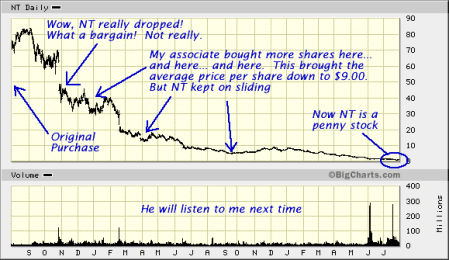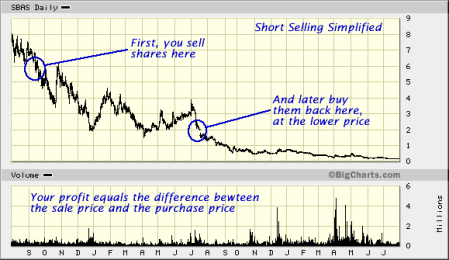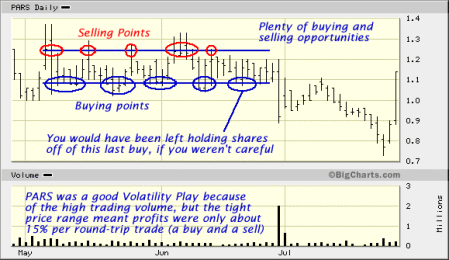


Get Instant Penny Stock Picks from the Authority!Visit www.PeterLeeds.com Right Now!
The price at which selling investors are willing to sell their shares to buyers. You can learn all about ask prices and trading penny stocks in the section on Trading Penny Stocks.

Buying more shares of penny stocks you already own, and getting the new shares at a lower price because the penny stock has been dropping.
Companies that are considered safe and conservative investments, with low downside risk. These stocks are widely held, have major market capitalizations, and have a certain degree of price stability. Companies like Ford, General Electric, and IBM are considered Blue Chip stocks. For a detailed explanation of the differences between Blue Chip and penny stocks, read Big Stocks vs. Penny Stocks.
The price that buying investors are willing to pay for shares of stock. You can learn all about bid prices and trading penny stocks in the section on Trading Penny Stocks.
When a stock ceases to be traded by a stock exchange it is considered delisted. There are various reasons a stock would get delisted, such as failure to meet the parent exchange's listing requirements, movement to another exchange, or being taken over by another company. There is a section about Halts and Delistings with Penny Stocks.
The amount of time you want a trade order to be active for. When you enter a buy or sell order, it can be 'good till close' (it will expire at the end of the day, whether filled or not), or good until a certain date you set (ie-good until friday, 18th). Orders expire at the end of the trading day unless you have set a longer duration. You can read more about this in buying penny stocks.
A method of researching a stock that looks at fundamental factors, which include; financial results, financial ratios, industry conditions, press releases, and more. View a full discussion of fundamental analysis, and details about how we use it to pick winning penny stocks
We have developed Leeds Analysis over many years. It is a method of combining fundamental and technical analysis to uncover the best penny stocks to invest in, and isolate the most advantageous prices to trade the penny stock.
When an exchange temporarily (or sometimes permanently) stops a stock from trading. In some cases, the company can request that their own stock be halted. Causes for halts are numerous, but usually involve the release of significant information that will have an impact on the share price. The halt allows for sufficient time for the news or announcement to disseminate through the shareholders. You can review the section on Halts and Delistings.
Diversifying exposure or managing risk through opposing investments. For example, you could buy an airline penny stock and an oil production penny stock. Higher oil prices would hurt one, but help the other.
The 'Cap' refers to capitalization (number of shares times price per share = company capitalization). Large capitalization stocks are worth hundreds of millions of dollars, as oppossed to small cap stocks, and penny stocks, which may be worth $50 million or less.
You want to buy or sell shares of a stock, and have specified the exact price you are willing to accept per share. A full discussion of limit orders can be found in Buying Penny Stocks.
The number of shares of a company times the price per share = the market capitalization. It is a method of quickly calculating a company's 'worth.' For example, ABC with 1 million outstanding shares at $2 each has a market cap of $2 million. If those shares dropped to $1.50, the market cap would drop to $1.5 million.
You want to buy or sell shares of a stock without providing a price per share that you are willing to accept. You will get the best available price at the time your order reaches the market. You can learn more in Buying Penny Stocks.
Here is a description of this stock market straight from the horse's mouth: As the world's largest electronic stock market, NASDAQ® is not limited to one central trading location. Rather, trading is executed through NASDAQ's sophisticated computer and telecommunications network, which transmits real-time quote and trade data to more than 1.3 million users in 83 countries. Without size limitations or geographical boundaries, NASDAQ's "open architecture" market structure allows a virtually unlimited number of participants to trade in a company's stock.
A sub-section of the NASDAQ (above), companies with smaller capitalizations or that can not meet the listing requirements of the main NASDAQ exchange, trade upon the Small Cap. Most stocks on the NASDAQ Small Cap are priced at $1.00 to $5.00 per share. In other words, most of them are penny stocks.
Over-The-Counter stocks refers to any issue that is not traded on a regulated exchange. You can review our full explanation of OTC stocks in our section, Where Do Penny Stocks Trade?
A regulated quotation service that displays real-time quotes, last-sale prices, and volume information in over-the-counter (OTC) equity securities. An OTC-BB equity security generally is any equity that is not listed or traded on NASDAQ or a national securities exchange. OTC-BB securities include national, regional, and foreign equity issues, warrants, units, American Depository Receipts (ADRs), and Direct Participation Programs (DPPs). In other words, it is a system for creating some regulation and accountability for stocks "without a home." There are many great penny stocks that are listed on the OTC-BB (and many not-so-great too). You can review our full explanation of OTC-BB stocks in our section, Where Do Penny Stocks Trade?
Keeping track of imaginary money in real investments, so that you can see how you would have done if you had actually traded.
When you trade only a portion of the shares you had intended. For example, you want to buy 4,000 shares of ABC, but at the end of the day have only aquired 1,500. You will still take a full commission charge from your broker for a partial fill.
Any share that trades under $5.00 is a penny stock.
The pink sheets are stocks that trade without any reporting requirements or regulation, and have no responsibility to you, the investor. They are very hard to buy and sell, as the trading activity in them is very low and sporadic. You can read all about pink sheet stocks in the section, Where Do Penny Stocks Trade?
The amount of uncertainty/speculation you are willing to accept with your investments. If you are prepared to lose your money but want to try and reap some massive returns, you have a high risk tolerance. If you lay awake at night worried about your $50 investment, you have a low risk tolerance.
Short selling is the strategy of selling the shares first, then having the commitment to buy them back at a later date. We have an entire section on Short Selling Penny Stocks.

The 'Cap' refers to capitalization (number of shares times price per share = company capitalization). Small capitalization stocks are worth a few million dollars, or perhaps as much as $50 million dollars, as oppossed to large cap stocks, which may be worth hundreds of millions, or penny stocks which may be worth a few million.
The aspect of investing whereby you take a chance or a gamble on a stock. The company may not have much value, and will probably become worthless, but if they strike gold, get that FDA approval, or discover a cure for AIDS, they could explode hundreds of times over in price. Many penny stocks are speculative investments because they are focused on an "all or nothing" result, such as a new biotech drug that may or may not work. Buying into the stock and hoping the drug ends up working is speculation.
The difference between the bid price and the ask price. With penny stocks, you will generally see a larger price spread. You can learn all about bid, ask, and spread in several sections, starting with getting started in penny stocks.
Filtering a list of stocks down into a smaller list based on your parameters. For example, there are thousands of penny stocks on the NASDAQ, but you could screen these down to all those shares under $2.00, that are profitable, and that are within 10% of their year low. Your shortened list may have only a few dozens penny stocks. Stock Screening is a great way to pull up a list of potential investments to which you could apply Leeds Analysis, in order to reveal the best penny stock investment. You can get a review of my favorite web tools, including the best stock screeners, in our picks for quality sites.
When one company buys out the shares of another, with the purpose being to aquire and run the other. Many penny stocks and their share prices benefit when they are aquired or taken over by a larger firm.
A method of stock research that looks at patterns on the trading chart in an attempt to predict future prices. We use technical analysis as part of our Leeds Analysis approach to discover the best prices at which to buy and sell penny stocks.
The letter combination that represents a particular stock. For the purposes of trading and researching stocks, you need to know the compnay's unique ticker symbol. For example, General Electric trades under the ticker symbol 'GE', while Paravant Computers trades under the ticker symbol 'PVAT.'
A method of trading penny stocks that myself and my team have developed. It involves buying and selling the same penny stocks, again and again, as they undergo repetitive fluctuations in price.

The number of shares that trade hands per day.